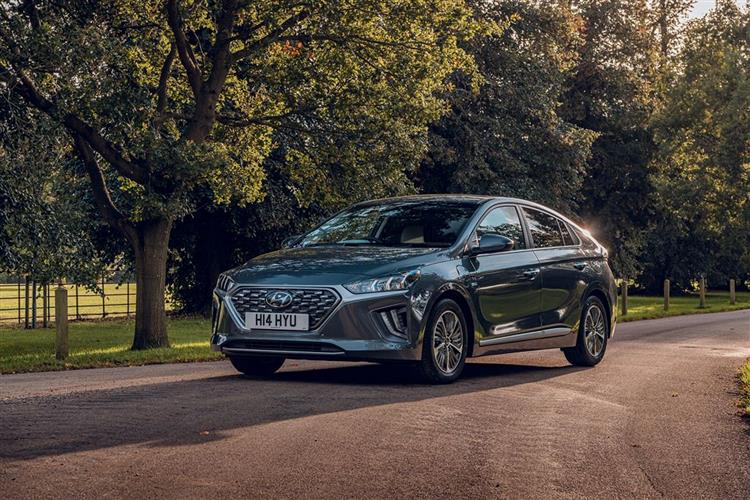PLUG POINT (some text hidden) --NONE--
By Jonathan Crouch
Introductionword count: 102
Back in 2017, the Hyundai IONIQ was the first car ever to go on sale with three different forms of electric power. Buyers chose from pure electric propulsion, self-charging full-Hybrid propulsion or, as in this case, a Plug-in Hybrid model. For those wanting electrified motoring without being tied to the variances of UK charging networks, this IONIQ Plug-in Hybrid looked a sensible choice. As well as its petrol engine, this Hyundai offered up to 32 miles of WLTP-rated all-electric driving range and CO2 emissions as low as 26g/km. It sold modestly when new though. Does it make sense as a used buy?
Modelsword count: 4
5dr family hatch (EV)
Historyword count: 217
Today, Hyundai is serious about eco-motoring. Deadly serious. Over the last few years, the company has launched a whole portfolio of eco-minded models, including Hybrids, PHEVs, full-electric vehicles and even a fuel-cell electric vehicle. But it all had to start somewhere - and did so back in 2017 with the IONIQ, which went on sale back then in full-Hybrid, full-electric and this Plug-in Hybrid form. All three were lightly updated in 2019. After which this Plug-in Hybrid variant remained one of the more affordable plug-in contenders of its kind on the market, aiming to offer buyers the best of both worlds; the all-electric capability of the full-Electric IONIQ model. And the range capability of the full-Hybrid version of this car. In Hybrid and PHEV Plug-in hybrid forms, the IONIQ went head-to-head with the car it was primary launched against, the Toyota Prius. Like its Hybrid and EV stablemates, the IONIQ Plug-in Hybrid sold until 2022 when it was a effectively replaced by a new wave of Hyundai full-Battery models like the IONIQ 5 and the second generation Kona (though neither could be had as a PHEV, a technology that by then, Hyundai was increasingly leaving to its partner Kia). So does this earlier Hyundai stab at semi-EV motoring make sense as a used buy? Let's find out.
What You Getword count: 539
There's not much point building a new car that offers three different electrified power trains for the first time ever if you're not going to make the most of every facet of its design. This is why Hyundai went to great lengths with the IONIQ to come up with a shape that offered a drag coefficient of just 0.24. That made this one of the most slippery shapes of its era, which helps reduce energy use and noise. The 2019 post-facelift design revisions included a smarter front grille and updated bumper styling. And inside? Well, inside this Hyundai, it doesn't feel futuristic. It's not that it's dull in the cabin: it's just that it's not trying to be too clever for its own good. We like that. What you get is a dash that bears a strong resemblance to the Korean company's other models from this time such as the i30 and Tuscon. That's a very good thing as it's clear and made from excellent materials. There are hints, though, at what lies under the bonnet, such as the battery indicator gauge on the left-hand side of the main 7-inch instrument display. It tells you how economically you're driving and whether or not you are using energy reserves or topping them up. The cabin of the facelifted model feels of noticeably higher quality than the original version launched in 2017. The big change lay with the addition of a big 10.25-inch Widescreen Navigation screen, part of a media package which included a very decent Infinity sound system, Apple CarPlay/Android Auto smartphone-mirroring and a suite of the brand's Bluelink connected telematics car services, these operating via a connected app. The main 'Map', 'Navigation', 'Radio' and 'Media' options are all easily accessible via a big touchscreen which also offers helpful EV info. Anything this central monitor can't tell you will probably be covered off by the 7-inch 'Driver's Supervision Cluster' screen which replaces the usual gauges in the instrument binnacle. When it's time to move rearwards and take a seat in the rear, that's a process that, unless you're really quite short, will involve the need for a slight incline of your head below the sloping roofline. Having done that, you might not be too surprised to find that once inside, as in, say, a Toyota Prius, headroom is at something of a premium for taller folk. Normally in a car this shape, the back seats would have been positioned a little lower to compensate for the swept-back ceiling, but that's not possible here since they sit right on top of the powertrain's battery pack. And the boot space on offer? Well some PHEVs manage to package in their batteries without encroaching on luggage room but that's not the case here. The 443-litre capacity you get in a conventional self-charging IONIQ Hybrid falls to 341-litres here - which is actually less than the full-electric version of this car, and around 100-litres less than in a conventional IONIQ Hybrid. At least beneath the boot floor you do get the space-saver spare wheel you'd have to do without on the IONIQ Electric variant. Hyundai provides four plastic pull-out tie-down points, but there are no bag hooks and you don't get a 12v socket.
To see the full road test text contact us on 0330 0020 227
Pictures (high res disabled)

.jpg)
|
.jpg)
|
.jpg)
| |||
.jpg)
|
.jpg)
|
.jpg)
| |||
.jpg)
|
.jpg)
|
.jpg)
| |||

|
Scoring (subset of scores)
Category: Hybrid, Plug-in, Electric & Hydrogen
| Performance | |
| Handling | |
| Comfort | |
| Space | |
| Styling, Build, Value, Equipment, Depreciation, Handling, Insurance and Total scores are available with our full data feed. | |



